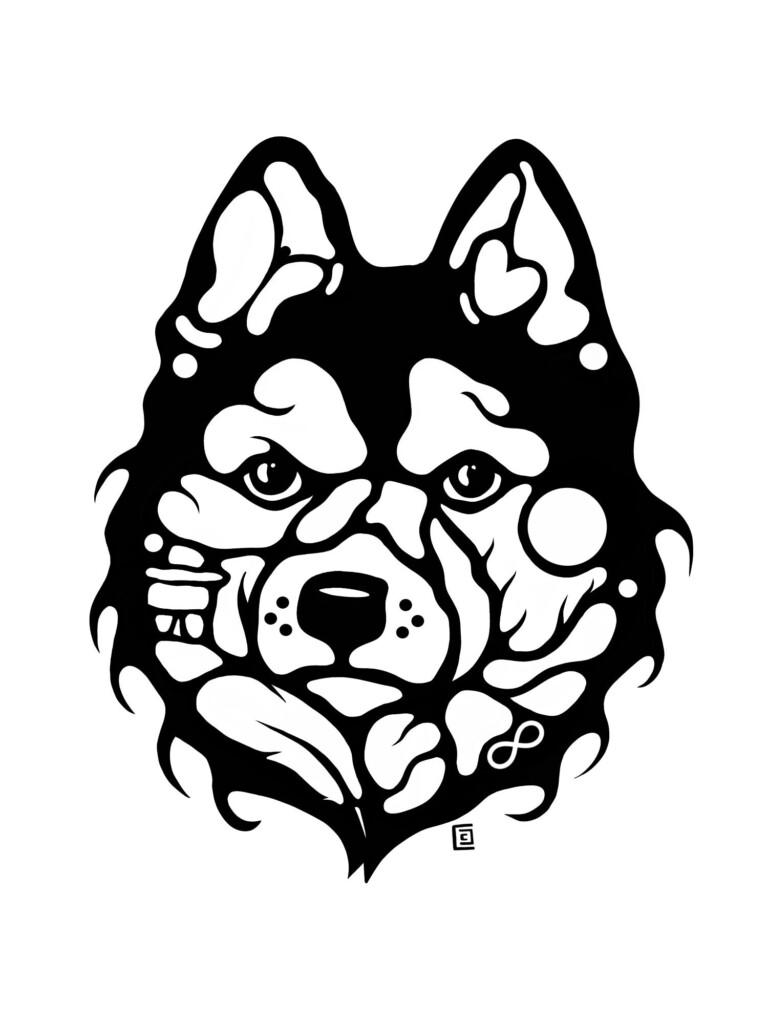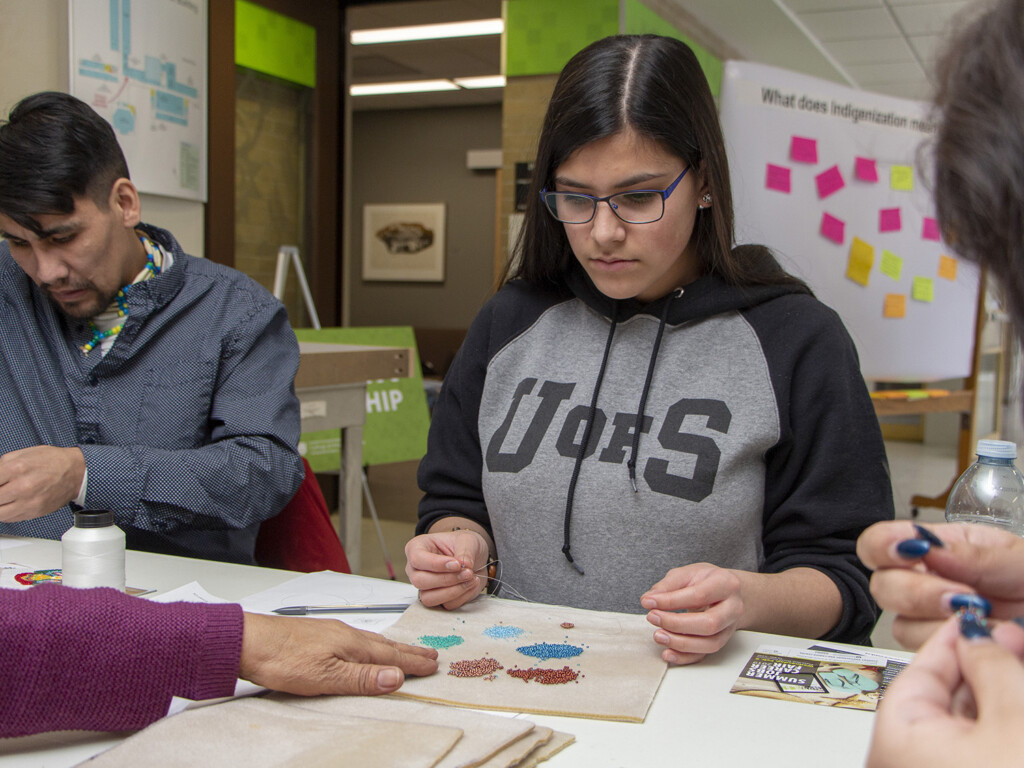In 2018, the Saskatoon Residential School Survivor Circle supported the request of the Huskie Cross Country team’s desire to race in orange singlets in honour of Residential School Survivors and the thousands of children who never made it home. This tradition continues today and has evolved to include all visiting athletes choosing to wear orange singlets for this annual race.
It’s one of the reasons why in recent years, the University of Saskatchewan’s Athletic Department has emerged as a leader in promoting inclusivity and empowerment for Indigenous communities through self-examination, community engagement and thoughtful strategic planning. At the forefront of these efforts is the department’s leadership and staff, who appreciate the diversity of Indigenous cultures and perspectives and through collaborative partnerships work to ensure integration is embedded into the fabric of their athletic programs.
“The University of Saskatchewan and Huskie Athletics embrace manitchitwin, which is the Cree/Michif translation of ‘let us respect each other’.”
As a result, in 2019, the development of an Indigenous Task Force, made up of community members and alumni, came together to explore opportunities within athletics for Indigenous engagement as well as the internal structures required to meaningfully support partnerships and education. In 2021, a renewed commitment to Indigenous inclusion came under the leadership of the new Chief Athletics Officer Shannon Chinn.
Foundational to their approach, Chinn said, is the principle of community engagement and collaboration. Instead of imposing predetermined strategies, the athletics department actively sought guidance from Indigenous communities, fostering a relationship built on mutual respect and understanding. This approach has proved pivotal in ensuring that initiatives resonate authentically with Indigenous people and communities.
As part of their strategy, Indigenous perspectives have been intentionally woven into various aspects of athletic operations. From the provision of procurement opportunities to the incorporation of cultural components and professional development, the Huskie Athletics department continues to strategically integrate the Truth and Reconciliation Commission (TRC) 94 Calls to Action within their organizational practices. Woven into the gameday experience are Indigenous dancers, drummers, the Treaty 6 Song and a custom land acknowledgement composed by student-athletes.
“These are not simple check box initiatives. The time, resources and effort put into creating and supporting these initiatives is enormous and to be honest at times daunting. But we have trust in community partners, staff and student-athletes, which make the journey that much more powerful and meaningful. It’s the behind the scenes work of these groups that I wish people could see, as it’s truly inspiring. It’s like Ray Lewis said, ‘the hardest thing to do is work hard when no one is watching’,” said Chinn.
A few initiatives of note are:
The Huskie Indigenous logo
One of the most visible initiatives the athletic department took on was the creation of the Huskie Indigenous logo. The idea took root when Chris Chipak, an artist from Red Pheasant First Nations, known as inchipakwetrust, shared his rendition of the Huskie logo on social media. This depiction struck a chord with the Indigenous student-athletes, leading to the start of a collaboration aimed at bringing this emblem to the University of Saskatchewan campus.

The captivating visuals in the new logo play a pivotal role in steering Huskie Athletics’ path towards reconciliation, symbolizing their deep connection with Indigenous communities and their intertwined bond with the land.
- Four circles – Four aspects of the medicine wheel. Reminder to carry a holistic approach throughout your journey.
- Butterfly – Represents a new beginning and hope for a better future.
- Heart – Used to build connections, community, and a sense of belonging.
- Treaty symbolism – Homage to the promise of the treaties; as long as the sun shines, grass grows, and river flows.
- Metis infinity symbol – Represents the Metis Peoples, the faith that shall live forever and the unity of two cultures.
- Feather – The ultimate gift you can receive in First Nations Culture. Represents the celebration of a full life from infancy to the elderly.
- Treaty 6 – Six dots represent the Treaty 6 land which USask is located on.
- Inukshuk – Represents the Inuit; symbolizes guidance, navigation and respect.
The logo embodies the university’s dedication to Indigenous representation and serves as a symbol of unity and pride. Additionally, the department went a step further by producing 750 orange T-shirts adorned with the logo, symbolizing solidarity with Indigenous communities.
WATCH: Huskie logo’s creative transformation
More Indigenous voices
The Huskie Athletics Indigenous student-athlete group, started in 2022, was instrumental in shaping initiatives like the new university logo. The group led by peers and alumni, serves as a platform for Indigenous student-athletes to voice their perspectives and shape the direction of athletic initiatives. Their influence has introduced elements of Indigenous culture and fostered understanding and engagement by creating educational and cultural experiences into Huskie Athletics.
“The main thing for me, personally was, I feel like I found a space that was more geared for me,” shared Kendra Farmer, a former track and field athlete and alumna of the Indigenous Huskies Athlete group.
For third-year Huskie hockey goalie, Roddy Ross, the impact of the university’s Indigenous student-athlete group and initiatives have offered him a safe space and an opportunity to learn more about his culture.
“Having this group means a lot to me… especially in university there are times where you feel like you’re quite alone,” Ross explained.
“And being First Nations, you’re kind of shy and you’re just a little bit worried on what’s going to happen and what university is going to look like. With this group, we have an open space for us to talk to anyone or if we have any questions; whether it’s school or hockey – it could be anything – if we want to smudge – we can get help. And then you learn a lot about your culture. So that’s a big thing for me since I didn’t really get to learn as much as I wanted to growing up.”
By recognizing the existing barriers to Indigenous participation in sport and working in partnership to dismantle these obstacles, the athletics department and the Indigenous student-athletes group are seeing the results of their hard work.
“The response from Indigenous communities has been overwhelmingly positive,” Farmer noted, highlighting the meaningful connections forged through cultural representation. “By incorporating Indigenous elements into game ceremonies, the athletics department has cultivated a sense of belonging and recognition among Indigenous spectators and athletes alike.”
Ross also highlighted the significance of programs like a ‘Day in a life of’, which is a mentorship initiative that pairs USask athletes with high school students, offering a glimpse into a typical day on campus. The program aims to break down barriers for Indigenous youth considering higher education and athletics.
Chinn said the impact of the mentorship program not only provides an understanding of university life but also serves as a source of motivation for the high school participants.
“It’s so important for these kids to see themselves, seeing the spaces designated for Indigenous people,” Farmer said.
“That there’s a space for them and see that their opinions and their voices and what they have learned growing up is valued if they go on into university. Or if they become a Huskie, that they’re going to be appreciated and they aren’t going to feel like they have to hide that part of themselves. So, I think that’s one of the really important things to come out of this initiative.”
Immersive experience: Indigenous excellence through the beading program

Another impactful USask initiative aimed at raising awareness of Indigenous issues and promoting cultural understanding has surfaced around the university’s opportunity to host the U SPORTS National Championships. During the 2023 Track and Field Championship, a partnership was formed with the Manifesting Academic Growth Promoting Indigenous Excellence (MAGPIE) program at Nutana Collegiate high school.
Student-Athletes, coaches, and staff worked with Indigenous leaders and students from the MAGPIE program to learn the craft of beading, collaborate, share space and have conversations. The partnership and beading program continued in 2024 with the hosting of the U SPORTS Women’s Hockey National Championship, providing the opportunity again to handcraft gifts with Indigenous leaders for each participant.
As part of this partnership, 800 beaded lanyards were distributed during the 2023 USPORTS Track and Field National Championships and 300 keychains made of traditional elements along with beading were distributed during the 2024 Women’s hockey national championships in Saskatoon.
The beading program not only added a unique cultural touch to the championships but also contributed to spreading awareness about the importance of social justice issues such as Every Child Matters and Missing and Murdered Indigenous Women. The value in these initiatives over the 2 years is not in what Huskies accomplished as a team, but in the how and the why.
“This lanyard gift is meaningful and given that this was the first and only track meet I’ve attended where there was intentional effort put towards reconciliation. I still have this lanyard attached to my backpack as a reminder of the meet. The lanyard to me carries positive energy wherever I bring it, not just due to the cultural significance and intention behind the people who made it but also since it reminds me of the first time I’ve seen and experienced track and field contested in a more inclusive sense,” said Adam Nuraddeen, a Carleton University track and field athlete, who competed in the 2023 national championships.
Challenges and future plans
“Nothing about us, without us” is a motto for Huskie Athletics. Listening to Indigenous student-athlete voices lead to the outcomes of the creation of the Huskie Indigenous logo, the beading program, and the impactful ‘Day in the life of’ initiative. These actions are fostering a sense of community and breaking down barriers for Indigenous youth.
But navigating the landscape doesn’t come without its challenges. Chinn acknowledges that sustaining these efforts requires ongoing commitment and consistency. But by embedding Indigenous perspectives into the fabric of Huskie athletics, the department aims to keep moving forward with fostering long-term relationships built on trust and respect.
Through these endeavors, Chinn said, the Athletics Department ongoing commitment to Indigenous representation continues to evolve, enriching the university’s athletic community and contributing to broader initiatives of reconciliation and cultural appreciation.